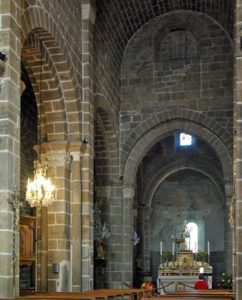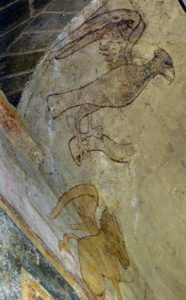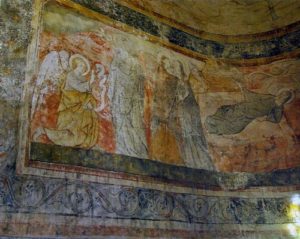Polignac is dominated by its fortress on top of a large flat volcanic hill. Below it is the small settlement with the church.
Eglise Sainte-Anne et Saint-Martin-de-Polignac is a Romanesque building with a 10/11thC choir and 12thC nave, although the upper parts of the nave were rebuilt in the 17thC. It was extended in the 19thC when the Romanesque facade was removed and the massive open porch over south door (locked) built. Over the transept is a short square tower with louvred bell windows and triangular porticos. It has a short spire with deep maroon and yellow roof tiles.
Entry is through west door. which has arches of black and white bands of stone above a black and white diamond trypanum. The church is built using dark volcanic rock except for the carved capitals of the pillars which are of a softer white rock from Blavozy.
The inside is typical of a Romanesque building with tall mult-angular pillars and round arches between the nave and side aisles. The white Blavozy stone stands out against the darker volcanic stone. The carved capitals are a mixture of acanthus leaves, animals and human heads. The round topped stained glass windows have pictures of saints and the baptism of Christ by John the Baptist.
There are statues of St Roch, Jean of Arc, and St Antoine de Padoue on north wall. There is a crucifix on the south wall and statues of Joseph with the boy Jesus and St Theresa. The chancel pillars have carvings of St Martin and St Philomene with an anchor and spray. Coats of arms of the Polignac family are on the north wall of the chancel. Scattered round the church are five processional crosses with crucifixes.
The carved wooden pulpit has the four evangelists carved on the side panels and Jesus on the back wall.
Chapelle St Anne in the north transept has a host box with beautifully embroidered cover with images of God and the Virgin in bright scarlet robes, surrounded by scrolls and leaves. Above is a small crucifix and a modern painting of the Holy Family on the wall above the altar.??? In a niche in the west wall is a 14thC polychrome statue described as a Trinitarian Sainte Anne because it has St. Anne, the Virgin and the Child Jesus all sitting on each other.
There is a large white stone mass altar with gilt decoration on the front and a cross with a gilt cross and candlesticks on the top. Behind is the high altar which has a gilt M monogram in a roundel on the base with gilt drapes above. Behind is a small retable with shelves with gilt decoration and an integral gilt host box with a crucifix standing on it. Above five fluted pillars arranged in a semi-circle support and arched canopy with a cross. There is a small statue of Curé d’Ars next to the high altar. Stained glass windows in the wall above the apse have God the Father in the centre with Mary and Jesus on the north and Joseph the carpenter with the boy Jesus to the south.
Behind the high altar are three smaller apses. The apse behind the high altar has a triangular wooden book stand with a large hymn book and a wooden table. There are beautiful 12thC frescoes on the walls showing the Last Judgement with Heaven and the angels on the south side and Hell on the north with a picture of demons carrying off dead bodies. There is a small wall niche with a statue of the Virgin and child and a silver decorative plate with a crucifix. On the opposite wall is a niche with an ostensoire and candlesticks.
The marble altar in the north apse has an inlaid pattern with outlines of red and gilt diamonds. The shelves and integral host box of the retable have a similar design. Above is a statue of Notre-Dame de Lourdes, framed in the light of the window behind. There is a fresco of an angel holding a book and playing a lute.
The south apse has a stone altar with a gilt carving of the Virgin Mary and 15thC frescoes of the Annunciation, the Nativity, the shepherds and the three kings bringing gifts with an eagle and gryphon on the ceiling.
Guide books give details of the fortress but there is only a fleeting mention of the church. There is little information on the web, yet the frescoes are beautiful and well worth a visit.










